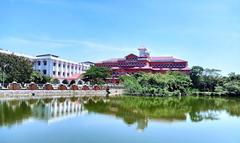
Comprehensive Guide to Visiting Kannur, Kannur District, India
Date: 30/07/2024
Captivating Introduction
Welcome to Kannur, a coastal gem nestled in the northern reaches of Kerala, India. Imagine stepping into a land where history whispers from ancient megalithic burial sites, and the air is infused with the tantalizing aroma of Malabar spices. Kannur is a treasure trove of cultural and historical riches, boasting a narrative that stretches from the Neolithic era to the bustling present day. This guide will take you on a whimsical journey through time, revealing the secrets and stories that make Kannur a must-visit destination. From the bustling port of Naura, the ancient equivalent of Wall Street, to the mesmerizing ritualistic performance art of Theyyam, Kannur offers a unique blend of history, culture, and natural beauty. Get ready to explore colonial forts, hidden beaches, and vibrant local traditions in this captivating corner of Kerala. Let’s dive into the heart of Kannur and uncover the gems that await you. (Wikipedia, FabHotels)
Table of Contents
- A Whimsical Journey Through Kannur’s History
- Pre-History and Ancient Era: Where It All Began
- Medieval Period: Trading Tales
- Colonial Era: Forts, Fights, and Foreigners
- British Raj: Resistance and Resilience
- Post-Independence Era: New Beginnings
- Cultural Significance: The Heartbeat of Kannur
- Key Historical Sites: Must-Visit Marvels
- Hidden Gems and Local Secrets: Off the Beaten Path
- Visitor Tips: Know Before You Go
A Whimsical Journey Through Kannur’s History
Pre-History and Ancient Era: Where It All Began
Imagine a time when the only skyscrapers were rock-cut caves and megalithic burial sites. Welcome to Neolithic Kannur! The area’s archaeological richness, featuring dolmens, stone circles, and menhirs, screams ‘early human habitation’ louder than a caveman discovering fire for the first time. Yes, folks, Kannur has been bustling with life and sophisticated burial practices since the dawn of civilization (Wikipedia).
Fast forward to the Sangam period (1st–5th century CE), and Kannur was the Beyoncé of ancient kingdoms, reigning supreme from Ezhimala. This kingdom’s port, Naura, was the ancient equivalent of Wall Street, a bustling hub connecting the world (Wikipedia).
Medieval Period: Trading Tales
By the 12th century, Kannur was the medieval Amazon.com, with traders flocking from Persia and Arabia. While Kozhikode was the CEO of economic status, Kannur was the trusty COO, along with Kollam and Kochi, making sure all business ran smoothly. Picture a medieval marketplace buzzing with global traders, and you’ve got medieval Kannur (Wikipedia).
Colonial Era: Forts, Fights, and Foreigners
Enter the Portuguese in 1498, stage left. Dom Francisco de Almeida built the St. Angelo Fort in 1505, and Kannur’s colonial chapter began. This fort was the ultimate power symbol and a game-changer for the region (FabHotels).
The Dutch, not to be outdone, captured the fort in 1663, spruced it up with bastions named Hollandia, Zeelandia, and Frieslandia, and then sold it to Ali Raja of Arakkal in 1772. The British later conquered it in 1790, making it one of their major military stations (Wikipedia).
British Raj: Resistance and Resilience
During the British Raj, Kannur was part of the Madras province. Local hero Kerala Varma Pazhassi Raja led resistance efforts, proving that Kannurites aren’t to be messed with. Kannur and Thalassery became modern municipalities on November 1, 1866, among the first in Kerala (Wikipedia).
Post-Independence Era: New Beginnings
Post-1956, Kannur became part of the newly formed Kerala state. The district saw several territorial changes, with North Wayanad Taluk forming Wayanad District in 1980 and Kasaragod and Hosdurg Taluks forming Kasargod District in 1984 (Wikipedia).
Cultural Significance: The Heartbeat of Kannur
Kannur is a cultural cornucopia, famed for the mesmerizing ritualistic performance art of Theyyam. It’s like watching history, mythology, and theatre blend into one spellbinding spectacle. Head to the Kerala Folklore Academy in Chirakkal to dive deep into these traditional art forms (Wikipedia).
Key Historical Sites: Must-Visit Marvels
St. Angelo Fort
Built by the Portuguese in the 16th century, St. Angelo Fort offers panoramic views of the Arabian Sea and a deep dive into colonial history. It’s a must-visit spot for history buffs and Instagram enthusiasts alike (FabHotels).
Thalassery Fort
Constructed by the British in the 18th century, Thalassery Fort is a colonial relic that’s perfect for a historical day trip. Think of it as a time machine to the British era (FabHotels).
Arakkal Museum
Located in the former residence of the Arakkal family, this museum gives you a peek into the lives of Kerala’s only Muslim royal family. It’s a fascinating blend of history and culture (FabHotels).
Hidden Gems and Local Secrets: Off the Beaten Path
- Muzhappilangad Drive-in Beach: How about driving your car along a 4 km stretch of golden sand? It’s the only drive-in beach in Kerala!
- Parassinikkadavu Snake Park: Not for the faint-hearted, this park is home to a variety of snake species.
- Dharmadam Island: A secluded paradise reachable only during low tide. Perfect for a Robinson Crusoe experience.
Visitor Tips: Know Before You Go
- Best Time to Visit: October to March is the sweet spot for pleasant weather.
- Local Cuisine: Don’t leave without trying Thalassery biryani, seafood dishes, and traditional Kerala snacks.
- Transportation: Kannur is well-connected by road, rail, and air. The Kannur International Airport is your gateway.
- Accommodation: From budget to luxury, Kannur has it all.
Discovering Kannur: The Beating Heart of Kerala’s Coast
Travel Documentation and Health Precautions
Before you set foot in Kannur, make sure your travel documents are as ready as your sense of adventure. You’ll need a valid passport and visa. Don’t skip on checking for recommended vaccinations either – safety first! For more details, check out the travel guide on Tripzilla.
Best Time to Visit
Imagine sipping coconut water while the sun kisses your skin – that’s Kannur between October and March. The weather is just right for beach lounging and exploring. Avoid the monsoon season (June to September) unless you’re a fan of dramatic rain shows. Check Holidify for the best visiting times.
Getting There
By Air
Fly into Kannur International Airport (CNN) and let the coastal breeze welcome you. Regular flights connect Kannur to major Indian cities and a few lucky international spots. For flight details, visit Holidify.
By Train
Choo-choo your way into Kannur railway station, a well-connected gateway with trains from various cities. Centrally located, it’s your ticket to exploring. For train schedules, check Indian Railways.
By Road
Hop onto a bus or drive down well-paved highways connecting Kannur to nearby cities. State-run and private buses keep the wheels turning. For road travel options, visit Kerala State Road Transport Corporation.
Local Transport
Zipping around Kannur is a breeze with auto-rickshaws, taxis, and buses. Auto-rickshaws are perfect for short hops, while taxis are your go-to for longer jaunts. For public transport schedules, check Kerala State Road Transport Corporation.
Accommodation
From opulent resorts to cozy homestays, Kannur has a bed for every budget. Check out Holidify for a place to rest your head after a day of adventure.
Currency and Payments
Carry some Indian Rupees (INR) for those quaint market buys. ATMs are plentiful, and cards are widely accepted. For current exchange rates, visit XE Currency Converter.
Language and Communication
Malayalam is the melody of Kannur, but English is your trusty sidekick. Sprinkle in some Malayalam phrases to charm the locals. Check Omniglot for language tips.
Cultural Etiquette
Kannur’s rich traditions are a tapestry of customs. Dress modestly, especially in temples. Shoes off before entering sacred spaces! For more etiquette tips, refer to Tripzilla.
Safety Tips
Kannur is safe, but a pinch of caution goes a long way. Secure your belongings, steer clear of lonely spots after dark, and be wary on public transport. For more safety tips, visit Travel Safe - Abroad.
Local Cuisine
Your taste buds are in for a treat with Malabar delights like biryani and seafood. Check Holidify for the best food spots.
Festivals and Events
Dive into Kannur’s vibrant festivals like Theyyam, Vishu, and Onam. For event details, visit Kerala Tourism.
Shopping
Bag some handloom textiles, spices, and crafts. Explore markets on Fort Road, Thalassery, and Payyambalam. For shopping tips, refer to Tripzilla.
Emergency Contacts
Keep these numbers handy:
- Police: 100
- Ambulance: 102
- Fire Brigade: 101
- Kannur International Airport: +91 490 248 1000
- Kannur Railway Station: +91 497 270 5555
More contact info at Kerala Police.
Responsible Tourism
Respect the environment and local customs. Avoid littering, use eco-friendly products, and support local businesses. For more tips, visit Responsible Travel.
By following these tips, you’ll have a blast in Kannur. For more planning info, check Holidify and Tripzilla.
Conclusion: Your Kannur Adventure Awaits
From ancient megalithic sites to colonial forts, Kannur offers a mesmerizing journey through time. With the enchanting art of Theyyam and hidden gems scattered throughout, it’s a treasure trove for history buffs and cultural explorers. Ready to explore? Download the Audiala app for beautifully crafted audio guides that will make your Kannur adventure unforgettable. (Wikipedia, FabHotels)
References
- Wikipedia contributors. (n.d.). Kannur district. In Wikipedia, The Free Encyclopedia. Retrieved from Wikipedia
- FabHotels. (n.d.). Places to visit in Kannur. Retrieved from FabHotels

